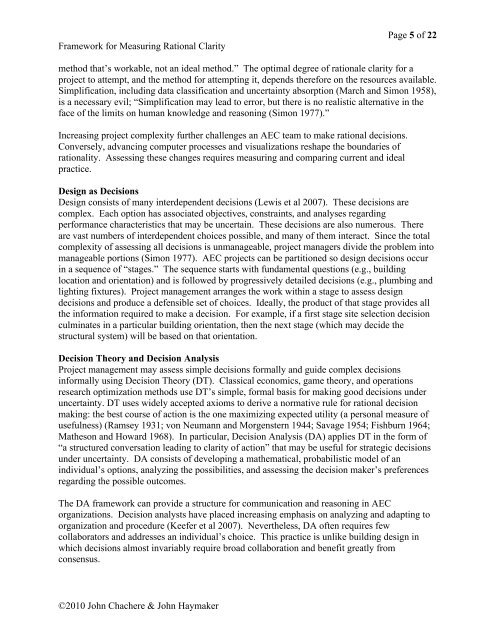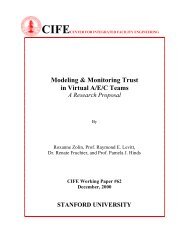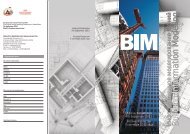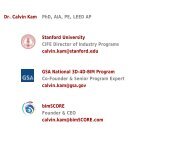Framework for Measuring Rationale Clarity of AEC Design Decisions
Framework for Measuring Rationale Clarity of AEC Design Decisions
Framework for Measuring Rationale Clarity of AEC Design Decisions
You also want an ePaper? Increase the reach of your titles
YUMPU automatically turns print PDFs into web optimized ePapers that Google loves.
<strong>Framework</strong> <strong>for</strong> <strong>Measuring</strong> Rational <strong>Clarity</strong><br />
Page 5 <strong>of</strong> 22<br />
method that’s workable, not an ideal method.” The optimal degree <strong>of</strong> rationale clarity <strong>for</strong> a<br />
project to attempt, and the method <strong>for</strong> attempting it, depends there<strong>for</strong>e on the resources available.<br />
Simplification, including data classification and uncertainty absorption (March and Simon 1958),<br />
is a necessary evil; “Simplification may lead to error, but there is no realistic alternative in the<br />
face <strong>of</strong> the limits on human knowledge and reasoning (Simon 1977).”<br />
Increasing project complexity further challenges an <strong>AEC</strong> team to make rational decisions.<br />
Conversely, advancing computer processes and visualizations reshape the boundaries <strong>of</strong><br />
rationality. Assessing these changes requires measuring and comparing current and ideal<br />
practice.<br />
<strong>Design</strong> as <strong>Decisions</strong><br />
<strong>Design</strong> consists <strong>of</strong> many interdependent decisions (Lewis et al 2007). These decisions are<br />
complex. Each option has associated objectives, constraints, and analyses regarding<br />
per<strong>for</strong>mance characteristics that may be uncertain. These decisions are also numerous. There<br />
are vast numbers <strong>of</strong> interdependent choices possible, and many <strong>of</strong> them interact. Since the total<br />
complexity <strong>of</strong> assessing all decisions is unmanageable, project managers divide the problem into<br />
manageable portions (Simon 1977). <strong>AEC</strong> projects can be partitioned so design decisions occur<br />
in a sequence <strong>of</strong> “stages.” The sequence starts with fundamental questions (e.g., building<br />
location and orientation) and is followed by progressively detailed decisions (e.g., plumbing and<br />
lighting fixtures). Project management arranges the work within a stage to assess design<br />
decisions and produce a defensible set <strong>of</strong> choices. Ideally, the product <strong>of</strong> that stage provides all<br />
the in<strong>for</strong>mation required to make a decision. For example, if a first stage site selection decision<br />
culminates in a particular building orientation, then the next stage (which may decide the<br />
structural system) will be based on that orientation.<br />
Decision Theory and Decision Analysis<br />
Project management may assess simple decisions <strong>for</strong>mally and guide complex decisions<br />
in<strong>for</strong>mally using Decision Theory (DT). Classical economics, game theory, and operations<br />
research optimization methods use DT’s simple, <strong>for</strong>mal basis <strong>for</strong> making good decisions under<br />
uncertainty. DT uses widely accepted axioms to derive a normative rule <strong>for</strong> rational decision<br />
making: the best course <strong>of</strong> action is the one maximizing expected utility (a personal measure <strong>of</strong><br />
usefulness) (Ramsey 1931; von Neumann and Morgenstern 1944; Savage 1954; Fishburn 1964;<br />
Matheson and Howard 1968). In particular, Decision Analysis (DA) applies DT in the <strong>for</strong>m <strong>of</strong><br />
“a structured conversation leading to clarity <strong>of</strong> action” that may be useful <strong>for</strong> strategic decisions<br />
under uncertainty. DA consists <strong>of</strong> developing a mathematical, probabilistic model <strong>of</strong> an<br />
individual’s options, analyzing the possibilities, and assessing the decision maker’s preferences<br />
regarding the possible outcomes.<br />
The DA framework can provide a structure <strong>for</strong> communication and reasoning in <strong>AEC</strong><br />
organizations. Decision analysts have placed increasing emphasis on analyzing and adapting to<br />
organization and procedure (Keefer et al 2007). Nevertheless, DA <strong>of</strong>ten requires few<br />
collaborators and addresses an individual’s choice. This practice is unlike building design in<br />
which decisions almost invariably require broad collaboration and benefit greatly from<br />
consensus.<br />
©2010 John Chachere & John Haymaker











